Surinder Siama
First published in Research World March 2009
We talk to marketing and market research experts about the impact of mobile technology on the region.
November 26th 2008: A date permanently etched in many peoples’ minds. It was the day on which events in Mumbai stunned India and the world. It’s also the day that Rinita Singh, managing director of Quantum Market Research in India, says demonstrated the power of mobile phones and their ability to connect people at a critical time. The fact that those captured by gunmen in the city could communicate with loved ones and, in some cases, directly with authorities, probably saved lives as well as provided much needed comfort.
It’s an extreme example of the good that mobile technology can bring to society – a demonstration of a technology that marketing and market research experts agree will be a key growth driver throughout this region.
When it comes to technology adoption, APAC is, of course, a tale of two regions: high penetration, developed markets such as Japan, South Korea and Singapore; and the low penetration, fast-growth goliaths, China and India.
According to a recent study by the China Internet Network Information Centre, China has 633.8 million mobile phone users, more than any other country in the world, with a penetration of under 30%. According to industry body ITU, India has around half this number with a lower penetration of around 20%. Low penetrations and large populations generate real excitement over the growth potential.
The growth in these low-income markets, particularly over the last couple of years as prices have come down, suggests that mobiles are no longer regarded as a luxury item: “Everyone on the street, every taxi driver, everyone in rural India is slowly moving onto having a communication device. In terms of the mindset shift, it’s huge,” says Singh.
What’s more, mobile adoption has had a positive impact on macroeconomic growth. According to India’s Economic Times, “in a yet-to-be-released study from the Indian Council for Research on International Economic Relations, Indian states with 10% higher mobile phone penetration enjoy 1.2% higher annual average growth rates than those with a lower teledensity”.
Popular apps
Singh says that in India, “A lot of usage of mobiles is restricted to basic telephoning and texting; there is no concept of the value-added services.” That’s what one would expect, particularly given that a large proportion of the handsets sold in India only offer basic functionality.
Moreover, 3G, which facilitates faster mobile data speeds and a richer set of services, is some way off in India, whose government has delayed the auction of 3G licenses until the economic climate favours a better price. And 3G is only starting to be deployed in China; it typically takes a few years to reach a meaningful proportion of the population.
Even those markets that do have 3G, such as Japan and South Korea, have failed to see rapid adoption due to the lack of killer applications. The only emerging killer application, also in the West, is mobile USB dongles that are sold separate from mobile plans and enable laptop users to get fast, untethered internet access.
Michihiro Ota, president’s office director at Japan’s largest research agency, INTAGE in Tokyo, says that leading carriers in Japan, including NTT DoCoMo, have started offering a mobile TV service on 3G handsets. However, this is likely broadcast rather than via the 3G connection.
One mobile service that does seem to be gaining traction in a number of developed APAC markets is mobile payment services. Ota says that among other similar services available, NTT DoCoMo’s i-Mode e-wallet service can be used to purchase travel tickets, as well as items at vending machines and selected convenience stores. The initial monthly spend is limited to around US $110 and is added to the user’s mobile bill. Ota says that the transaction fee charged for using the service is minimal, unlike in the West where fees can account for a large chunk (eg, 30%) of small transactions, perhaps explaining their lack of popularity there.
John Smurthwaite, chairman Asia Pacific, Latin America and Middle East & Africa at TNS, says that a similar payment system is in use in Hong Kong, while Barry Tse, managing director of WisdomAsia Marketing in China, says that mobile news services are popular there: “There are a lot of subscription-based push news services.”
Dream device
Smartphones and 3G are the future of mobile, for now at least. Smartphones that allow basic internet browsing such as Apple’s iPhone, Google’s G1 and Blackberry’s Storm, among others, have generated major consumer interest in 2008 due to their intuitive interfaces.
But in a sign that the sector may not be immune to the effects of the downturn, Apple recently reported that it sold fewer iPhones than expected in the last quarter. This is unlikely to be an issue in China, where a popular iPhone lookalike exists. “The Chinese product is far inferior to the real iPhone but has used software to mimic what the iPhone can do,” says Tse.
Researchers have long talked of the mobile phone as the dream data collection device because it’s the one device that people carry with them. Lack of ubiquity and sophistication have been key issues, and still are in APAC, but these are being addressed.
Mobile payment systems excite TNS’s Smurthwaite. He’d love to get hold of the transactional data (subject to user permission) so that he can monitor purchases made by his panelists. Along with colleague Stephen Jenke, regional director for South Asia & ALM Operations & Information Technology director at TNS, he is already exploring partnership opportunities with payment firms.
Ota mentions that INTAGE has a portable device that panelists use for similar purposes. Called Personal Eye, it’s designed to “scan barcode information at either vending machines or any places outside homes or inside stores.” Currently used by INTAGE’s panels in Tokyo and Osaka, users scan the barcodes of items purchased and this information is then uploaded daily to the central server. The data provides intelligence such as market share, purchase frequency and other aspects of consumption behaviour.
GPS tracking
Smurthwaite says that TNS has used mobiles to run an advertising effectiveness study at a live sporting event in Japan. Spectators read/swipe a barcode with their phone as they enter the stadium (most mid-to-high-range handsets have a barcode scanner). After the game, they are sent a text message to get feedback on the advertising.
GPS is an increasingly popular handset feature that researchers and marketers would dearly love to tap into. “GPS seems to be one of the new areas for marketing research. GPS is powerful for micro-area marketing purposes,” says Ota. The ability to track mobile users via GPS could help to identify better locations for new stores, or indeed help advertisers to know who passes their billboards.
There are, however, a couple of drawbacks. The GPS feature only tends to exist on higher-end handsets. More important to consumers is the issue of disclosing sensitive information to third parties. “A lot of people don’t want to be tracked, particularly husbands who are out for a late night!” says Smurthwaite. Given GPS is a useful consumer feature as it forms the basis of navigation systems, one way to address the privacy issue may be to offer consumers something useful (eg, a utility) in return.
All this talk of privacy reminds us that as our interactions become ever more digital, market research will increasingly want access to actual behavioural data to improve the quality of marketing decisions. But with that comes an obligation for the industry to start thinking about robust measures to absolutely safeguard consumer data.
Leapfrog technologies
Mobile phones are viewed as a leapfrog technology because they allow developing countries to totally bypass traditional landlines. TNS’s Smurthwaite discloses that APAC could soon benefit from another leapfrog technology.
This time it’s TV measurement. Smurthwaite says that household meters “are almost useless” in an era of hundreds or even thousands of TV channels. As a result, TNS has developed technology that provides “return path data which can determine what channels are tuned into within literally hundreds of thousands or millions of homes,” as opposed to existing systems that only poll a few thousand homes.
The system is already up-and-running in Australia, New Zealand and Hawaii. “Asia has leapfrogged the West with this technology,” he says, adding that while it cannot determine who is watching, “this will be modeled.”
WisdomAsia’s Tse says that his agency is one of the first to employ eye tracking in Hong Kong, Taiwan and China. While the equipment doesn’t come cheap (about EUR 40,000), particularly for a smaller agency, he’s already considering buying more of them following positive client feedback.
Useful for researching website usability, packaging design and online advertising effectiveness, Tse adds, “We’ve even used it to look at sponsorship, a football club T-shirt or a Formula 1 driver’s jacket; which part to place a sponsor’s logo.” It’s a testament, he says, to the nimbleness of smaller agencies, referring to his belief that bigger agencies are too slow to adopt new technologies because of decisions being taken far away from the region.
However wonderful technology can be for research, INTAGE’s Ota makes a plea for researchers to continue to connect with consumers in the real world: “Web 2.0 seems to have been getting people’s attention recently in online research … but ’real’ stimuli can only be provided through ‘real’ approaches such as face-to-face.” Well said.
Surinder Siama runs ResearchTalk.



